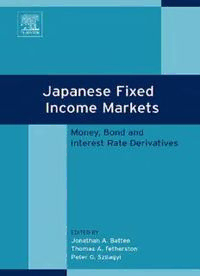
Japanese Fixed Income Markets: Money, Bond and Interest Rate Derivatives PDF
Preview Japanese Fixed Income Markets: Money, Bond and Interest Rate Derivatives
Japanese Fixed Income Markets: Money, Bond and Interest Rate Derivatives This page intentionally left blank Japanese Fixed Income Markets: Money, Bond and Interest Rate Derivatives Edited by J.A. Batten Graduate School of Management, Macquarie University, Sydney, Australia T.A. Fetherston† School of Business, University of Alabama at Birmingham, Alabama, US P.G. Szilagyi Department of Finance, Tilburg University, Tilburg, The Netherlands AMSTERDAM · BOSTON · HEIDELBERG · LONDON · NEW YORK · OXFORD PARIS · SAN DIEGO · SAN FRANCISCO · SINGAPORE · SYDNEY · TOKYO Elsevier Radarweg 29, PO Box 211, 1000 AE Amsterdam, The Netherlands The Boulevard, Langford Lane, Kidlington, Oxford OX5 1GB, UK First edition 2006 Copyright ©2006 Elsevier B.V. All rights reserved No part of this publication may be reproduced, stored in a retrieval system or transmitted in any form or by any means electronic, mechanical, photocopying, recording or otherwise without the prior written permission of the publisher Permissions may be sought directly from Elsevier’s Science & Technology Rights Department in Oxford, UK: phone (+44) (0) 1865 843830; fax (+44) (0) 1865 853333; email: This volume is dedicated to the memory of our dear friend and colleague Thomas A. Fetherston Jonathan A. Batten and Peter G. Szilagyi This page intentionally left blank CONTENTS 1. Japanese Fixed Income Markets: Money, Bond and Interest Rate Derivatives 1 J.A. Batten, T.A. Fetherston and P.G. Szilagyi MACROECONOMIC ENVIRONMENTAL DEVELOPMENTS 2. Recent Developments in Japan’s Corporate Bond Market 33 P.G. Szilagyi 3. The Past, Present and Future of the Securitization Market in Japan 51 R. Coman 4. Risk Management and Derivative Usage in Japan and Neighbouring Asian and Pacific Countries 77 M. Young and F.M. Chin 5. Macroeconomic Causes of a Decade of Deflation 105 R. Jerram 6. The Relationship between Interest Rates and Economic Activity: How the Conventional Literature has Dealt with the Japanese Experience 135 R.A. Werner CREDIT RISK MEASURES AND MANAGEMENT 7. Dynamic Equilibrium Correction Modelling of Yen Eurobond Credit Spreads 171 S. Pynnönen, W.P. Hogan and J.A. Batten 8. Hedging Market-Wide Credit Risk Using CDS Indexes: The Case of Japan 187 H. Byström 9. The Distribution of Yen Denominated Credit Spreads 207 C.A. Ellis and W. Hogan 10. The Japanese Credit Rating Environment: Insights from Issuers 233 L.M. Fairchild and Y.S. Shin vii viii Japanese Fixed Income Markets: Money, Bond and Interest Rate Derivatives 11. Credit Ratings in the Japanese Bond Market 257 N. Yamori, N. Nishigaki and Y. Asai INTEREST RATE ANALYSIS 12. Multifractal Modeling of the Japanese Treasury Term Structure 285 S. Jamdee and C.A. Los 13. Continuous Time Interest Rate Models in Japanese Fixed Income Mar- kets 321 K.B. Nowman MARKET INTEGRATION 14. How Integrated Are the Equity and Debt Markets? A Comparative Study of Japanese and the U.S. Capital Markets 349 H.-J. Cha, T. Jithendranathan and J. Kim 15. International Linkages of Japanese Bond Markets: An Empirical Analysis 371 B.N. Jeon, P. Ji and H. Zhang 16. International Linkages of the Japanese Government Bond Market: Time-Series Evidence 395 T.J. Brailsford, J.H. Penm and R.D. Terrell 17. Financial Market Integration: Evidence from Stock and Bond Markets in Japan and the US 413 J. Nagayasu Author Index 435 Subject Index 443 Chapter 1 JAPANESE FIXED INCOME MARKETS: MONEY, BOND AND INTEREST RATE DERIVATIVES Jonathan A. Batten, Thomas A. Fetherston, Peter G. Szilagyi, Editors 1. OVERVIEW The dynamic role of capital markets (here fixed income) to efficiently channel sav- ings funds from surplus sectors of the economy and to Finance private economic 1 ventures which promotes Economic Growth and Economic development, is a concept accepted and promoted by governments throughout the world. The role of Fixed Income Markets as an efficient tool in raising financing for Government projects (national and local) has been understood and appreciated for centuries (Homer and Sylla, 1996). The Japanese capital markets were liberalized and de- controlled after and increasingly opened to foreign participation in the 1970’s. The fixed income market particularly expanded to finance the government fiscal deficits commencing in 1975. However, growth in the non-Government side of the market for Japan has been a more recent phenomenon and a goal of policymakers in Japan and Asia since 1997. The growth in this phenomenon is presented in the data section below. These essential characteristics are the sine qua non of any viable fixed income market. A shortcoming in any of the important essential characteristics threat- ens the viability of that fixed income market. The essential characteristics are as follows: 1 McKinnon (1973) cites the importance of cycling scarce capital in a liberal financial environment as a positive component of the development process. Although most of the countries in this work are mature countries in the development process they too can and do benefit from capital markets (Fixed Income) which enhance and promote economic efficiency. 1
